Vireya Section Rhododendrons in California: A Preliminary Report
by Hadley Osborn
A few years ago when walking through Strybing Arboretum in midwinter I was astonished to see a rhododendron in full bloom with flowers of an unusual salmon-red color. It turned out to be 'Taylori', (Fig. 54) one of what we then called Javanicum hybrids, and it has since been joined by a selection of allied hybrids and species. This thriving planting in the protected area near the northeast boundary of the Arboretum is worth a special visit in winter, and occasional trusses may be found throughout the year.
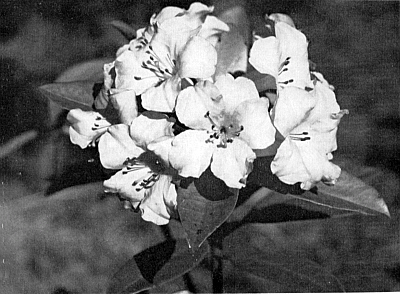
|
|
Fig. 54. R. 'Taylori' (
R. brookeanum
var.
graacile x 'Princess Alexandra'), a lovely pink hybrid exhibited by Veitch in 891 and which received an F.C.C. in 1935. P. H. Brydon photo |
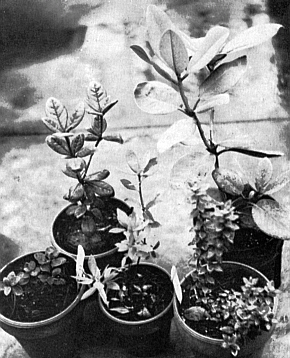
|
|
Fig. 56. Young seedlings at Strybing
Arboretum. From left to right, front row, R. commonae , R. luteosquamatum , R. yelliotii ; back row; R. acuminatum , R. konori . Bob Scott photo |
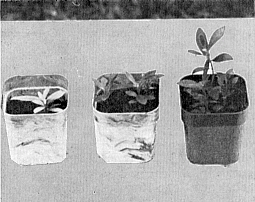
|
|
Fig. 58.
R. leucogigas
seedlings at
five months. Left pot "normal" rhododendron soil. Center pot, milled sphagnum. Right pot, tip of cutting in sphagnum. Bob Scott photo |
These rhododendrons belong to a separate Vireya Section of the genus and are now usually called Malesians, but since a couple of Irroratum Series species along with some azaleas and Stamineums also occur in Malesia, and since some Vireya species are found elsewhere (
R. kawakamii
in Formosa,
R. vaccinioides
in the Himalayas, etc.), it is perhaps best to call the group simply the Vireya Section. But whatever name, their finely modeled corollas in glowing colors not found elsewhere in the genus would be eye catching at any season, but in the dull days of winter they seem particularly bright and beautiful. However, those familiar with only the comparatively thin-leaved and occasionally stiff growing species and hybrids in the large Javanica Series have a very incomplete idea of the Section. The known wild material is currently organized into 7 Subsections and over 275 specific entities. I have young plants of only 40 of these, but they already show a greater range of flower and plant form than all other rhododendrons. Figure 56 shows a variety of plant and leaf structure in five young seedlings at Strybing.
R. konori
(back row on the right) has been introduced enough times so that it is clear that it partakes of the variability common to rhododendron. The best foliage forms, along with other species in its Phaeovireya Subsection, have bright, buff orange new growth that I find as beautiful as any foliage in the genus. The large, lush leaves of
R. leucogigas
would not appear at a disadvantage with Falconeri and Grande Series plants, and I have never seen finer flowers (cover). It is not just that they are the largest in the genus and wonderfully fragrant, but that they are so crisply and elegantly modeled. On the other hand, the neat little
R. gaultheriifolium
is reminiscent of the Saluenense Series in leaf and habit, while
R. quadrasianum
var.
rosmarinifolium
has a leaf and plant structure like one of the more upright and looser Lapponicums. The flowers of my plant, raised by Frank Doleshy from seed collected by Sleumer in the Philippines, are rich orange, but they are so small that the first three-flowered umbel was going over before I noticed it.
R. womersleyi
(Fig. 57) looks a little like a dwarf, succulent-leaved Vaccinium. The chandelier-like umbels of waxy red flowers produced by
R. wrightianum
var.
cyclopense
(Fig.55) have a unique grace that has made it the favorite of some, whereas one plant of
R. invasorium
in full bloom struck me as the most squalid rhododendron I'd ever seen.
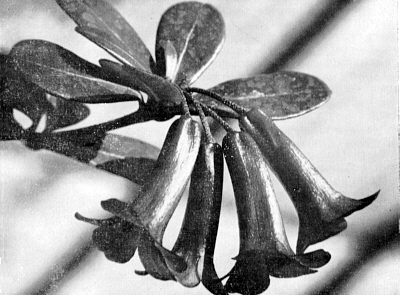
|
|
Fig. 55.
R. wrightianum
var.
cyclopense
, a graceful
species with pendant waxy red flowers P. H. Brydon photo |
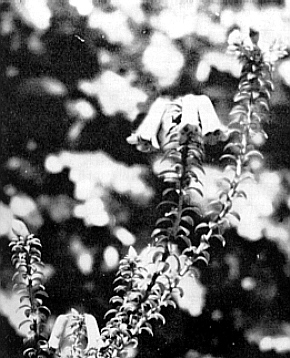
|
|
Fig. 57.
R. womersleyi
, Sunlight on the waxy,
bright red flowers makes them appear white in this photograph. Bob Scott photo |
This incredible variability carries over to the ecological niches they utilize. Species originally found growing epiphytically in pure organic debris are reported to be aggressively colonizing barren clay left from gold mining operations at Edie Creek, New Guinea.
R. inconspicuum
is reported at home both in mossy forests and on limestone ridges. Some species grow only on hot rock faces, whereas the gaudy, almost too bright yellow
R. laetum
is a swamp plant. Clearly, most generalizations about growing practices will be subject to exception.
The Vireya rhododendrons are most like one another in their seed. They are distinguished botanically by having seed with long tails, and enthusiasts soon find that the seed is also distinguished by retaining its viability for only a short time. Most of them occur where the growing season is continuous with the seed germinating as soon as it falls, unlike rhododendrons of temperate climates whose seed must preserve viability through the winter. Once Vireya Section seed is more than a couple of months old, little if any germination can be expected. As a result, Mrs. Berry has asked interested members to send her their want lists so that seed may be distributed as soon as received.
Fresh seed germinates readily in milled sphagnum, but the seedlings grow with frustrating slowness until they are two or three inches high. Attempt to push them with fertilizer, even extremely dilute organics, have resulted only in yellowed leaves and tip necrosis. Nor has the addition of fritted trace elements visibly improved their digestion. It appears that the best way to get them over their early doldrums is to have patience, to provide more heat and humidity than normal, and to plant them in an extremely lean planting medium. I have the best results with milled, unfertilized sphagnum. If, instead of pricking the seedlings out, they are simply cut off and inserted into sphagnum in polyethylene (see John Patrick's report of this process in the Jan. 1969
Quarterly Bulletin)
, they quickly form sturdier roots than the original seedlings and grow with more vigor. Figure 58 shows
R. leucogigas
seedlings in 2" pots when five months old. All were grown under continuous light. Despite the fact that most species occur where days and nights are always of equal length, they do respond to supplemental lighting, though not as dramatically as other rhododendrons. The plant on the left was pricked out into a compost that produced good growth in non-Vireya Section rhododendrons. The center pot shows the healthier leaves and slightly better growth of seedlings pricked out into sphagnum moss, and the right pot shows the vigor of tip cuttings taken when the center pot was pricked out.
Once the seedlings are 2-3" tall, they grow readily and are not nearly as fussy about their planting medium. At Strybing an extremely loose compost has been used to advantage, whereas a friend has healthy plants growing in adobe clay that has been only slightly modified with peat and pine needles. He cures occasional chlorotic tendencies with applications of chelated iron and finds the larger plants appreciate feeding. My own plants appear healthiest, as do all my non-Vireya rhododendrons, in raised beds of pine needles with no fertilizer added.
Most Vireyas appear as immune to pests and disease as other rhododendrons, but the thin leaves of some Javanica Series species and hybrids do present problems. Rust has occurred on plants near the ocean, and I've had occasional outbreaks of powdery mildew which yields readily to Karathane or Actidione PM. The latter material is reported to have caused leaf damage on other rhododendrons, and though I prefer its curative action it should be used with caution. One grower verified an infestation of spider mites, and the thin leaves prove palatable to a variety of caterpillars, with 'Sir George Holford' apparently being particularly tasty. Experimentally, I've applied a range of commonly used insecticides to Vireya rhododendrons (chlordane, malathion, sevin, meta-systox-r, even dimethoate which has damaged soft growth of other lepidotes) without observing any plant damage.
In short, once they are beyond the early stages the Vireyas present no unusual problems other than the crucial one of cold tolerance. The older, greenhouse-bred hybrids derived from low-land species are clearly tender plants. The remarkably, orange flowered 'Sir George Holford' appear to be particularly soft and was damaged though not killed in the U. C. Botanic Garden where the temperature fell to a mere 28°F. In the Fort Bragg area of California temperatures in the low 20's accompanied by strong winds wreaked havoc with all these hybrids and other lowland species, though once the plants are three to four years old they tend to sprout back from the base. Last winter at Strybing young plants of
R. dianthosmum
(collected at 990 meters, New Guinea),
R. christianae
(600-1525m.),
R. scabridibracteum
(2400m.) and
R. rarum
(2600m.) were tested in a frost pocket at the Nursery where a minimum of 22°F. was recorded, and all were killed to the ground with only
R. dianthosmum
(from the lowest elevation of the lot) yet sprouting back. In my own mild location, I've yet to lose a single plant, though growth produced on such species as
R. aurigeranum
and
R. zoelleri
during the coldest weather is almost pure white. Also, the heat loving
R. lochiae
from Australia develops anthocyanin spots in its leaves under the stress of temperatures even 10° above freezing. The albinistic young growth may be cut out and particularly spotted leaves removed, but these symptoms have disappeared with the return of warmer weather, and species from higher elevations remain unaffected. At least one form of
R. commonae
(which occurs at 26003990 meters in New Guinea) is reported to have endured a winter outdoors in Holland, and the Formosan
R. kawakamii
occurs in a temperate climate just feet away (and above, as it is always epiphytic) from the Barbatum Series
R. morii
, a species currently rated as hardy to zero.
Since Vireyas root from cuttings more readily than any other rhododendrons (with or without hormones, wounding, or bottom heat), they are already being widely distributed in the Bay Area, and the inevitable hybrid crosses are being made.
R. lochiae
has been reported to have the usual rhododendron diploid number of chromosomes (26), and Australian enthusiasts have readily crossed it with several Vireyas, so most apparently have the same number. Sleumer and others report a variety of probably hybrid swarms with fertile seed in the wild, and no barriers to hybridization have yet been reported within the Section. However, I know of no successful crosses outside of the Section, with the few reputed hybrids turning out to be the result of apomixis or of selfing. I've attempted to cross Vireyas with some of the more promiscuous diploid lepidotes, such as
R. moupinense
, without getting any hybrid seed as yet, and I'd be surprised if any given cross between a Vireya and non-Vireya had taken. On the other hand, I'd be much more surprised if such cross turned out to be ultimately impossible.
Barriers to fertility are not nearly as absolute as we tend to assume on the basis of a few failures. Hybridizers should be aware of special techniques that might be tried if all else fails, but. Alex Martin demonstrated with supposedly difficult lepidote-elepidote crosses that the only unusual techniques required were audacity and persistence. Nor should the hybridizing effort be confined to lepidotes. Michael Black has speculated that the Vireyas migrated and evolved along a coastal and off-shore Asian route, and certainly the lowland Stamineums, even the rigid, glossy leaves of Hong Kong's Argyrophyllum Subseries
R. simiarum
, have a Vireya air about them. Moreover, apart from scales, the Vireyas possess more features in common with elepidotes than with lepidotes. They have the elepidote color range, though with much brighter shades in the yellow-apricot-orange tones. The magnificent (and under the microscope magnificently beautiful) stellate and dendroid scales of the Phaeovireya Subsection appear to my layman's eye to have much in common structurally with some elepidotes' more elaborate indumenta. A number of Vireyas have developed waxy red tubular, five lobed, pendant flowers like the Neriiflorum, whereas others have the fragrant, whitish, seven-lobed corollas we know from the Fortunei Series. These latter similarities may simply be the result of convergent evolution due to the pollinator pressure of birds and moths respectively; but it should be remembered that evergreen azaleas, for example, will not cross with their presumably close, deciduous relatives, but will cross with lepidotes that are similar to them in many important respects due, it has been assumed, to convergent evolution.
In any event, the Vireyas offer the hybridizer a number of attractive features: huge flowers, rich fragrances. very bright and luminous colors, particularly the current fashionable yellows and oranges, and colors that intensify rather than fade as the corolla ages. Perhaps it will prove to be impossible to cross them with non-Vireyas, but it is surely worth more than a few tries.
Growers of Vireya rhododendrons need not explore hybridizing frontiers to feel like pioneers, however. Many have just been discovered, most have just been introduced, and doubtless many more remain to be found in areas that are blessedly politically accessible. The taxonomic work is fresh and will surely continue to undergo revision. It is fervently hoped that all growers will take special pains to preserve and, when propagating, transmit the data connected with their plants. In many cases the number or specific habitat information will prove more important than the name attached to the plant. Misspelled or illegible names may always be deciphered, but once a number is omitted or poorly transcribed, it is lost forever.
Aside from being outstandingly beautiful at their best, the Vireyas are particularly intriguing to anyone interested in theories of plant migration, speciation, variation, inheritance mechanisms, etc. My personal thanks to Jock Brydon who was aware of their ornamental possibilities and was importing them for Strybing Arboretum long before most of us knew of their existence, and to the altogether remarkable Michael Black who has had the initiative and energy to find so many of them amongst the rains and leeches of New Guinea, and then to give so generously of his introductions.